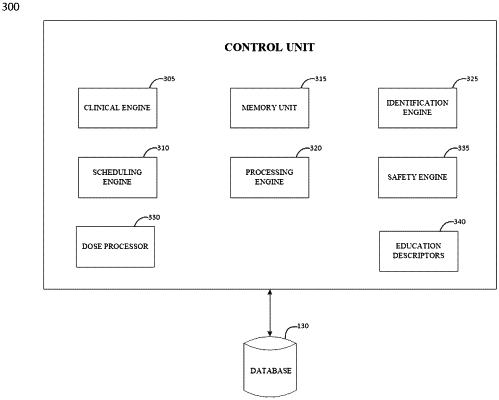| CPC G16H 20/10 (2018.01) [G16H 10/60 (2018.01); G16H 40/67 (2018.01)] | 16 Claims |

|
1. A system, comprising:
a first graphical user interface (GUI); and
a computing system, configured to:
receive, via the first GUI, an input of a plurality of medications from a user patient, wherein for selecting the input of the plurality of medications, the system provides identifications of medications through visual icons of the medications, including size, shape and other characteristics of the medications;
generate or update a patient profile for the user patient, which comprises a daily medication routine for the user patient, based on a mapping the input of the plurality of medications with a pre-stored set of instructions and information of the plurality of medications, wherein information regarding the plurality of medications is viewable via the first GUI, and wherein medications added to the patient profile are amendable via the first GUI;
identify an instance where the user patient changes the patient profile;
generate an alert according to the identification of where the user patient changes the patient profile; and
upon generation of the alert, communicate, via a second GUI, the alert to additional users that are identified as other stakeholders of the patient profile, and
wherein the first GUI is further configured to:
display, via a first screen, a screen shot of a medication of the plurality of medications; and
display, via a second screen, an icon showing a shape, size, and color of the medication of the plurality of medications;
wherein the computing system is further configured to:
generate the visual icons of medications by mapping the input of the plurality of medications with a pre-stored set of images;
receive, via the first GUI, an input on the shape, size, and color of the plurality of medications;
further generate the daily medication routine according to the input on the shape, size, and color of the plurality of medications;
provide fields in the first and second GUIs or additional GUIs for the user to edit and amend a dietary and medication schedule as well as change the plurality of medications, amend the plurality of medications and opt to receive or snooze the alert and other alerts and notifications associated with the routine; and
safety check to ensure the medications that are being consumed are devoid of conflicts and to ensure the user complies with safe dosing, which includes considering conflicts from drug-drug interactions, conflicts from drug-food interactions, conflicts from drug-disease interactions, conflicts from drug-immunization interactions, conflicts from drug-allergy interactions, conflicts from therapeutic duplications, and other clinical rules;
record patient interactions with the patient profile as adherence data;
identify an instance where the user patient neglects to interact with the patient profile for a predetermined period of time;
generate a second alert according to the identification of where the user patient neglects to interact with the patient profile for the predetermined period of time;
upon generation of the second alert, communicate, via the second GUI, the second alert to the additional users that are identified as the other stakeholders of the patient profile; and
generate and display statistics and metrics derived from the adherence data, and wherein the metrics provide comparisons and analytics pertaining to performance of the user in medication management and provide levels of adherence to the routine by the user,
wherein the first GUI is further configured to receive an input that the user patient is experiencing certain side effects from the daily medication routine,
wherein the computing system is further configured to activate a second alert based on the receiving of the input that the user patient is experiencing certain side effects from the daily medication routine,
wherein the upon generation of the second alert, the computing system is further configured to communicate, via the second GUI, the second alert to the additional users that are identified as the other stakeholders of the patient profile,
wherein the first GUI displays a chat feature configured to facilitate the user patient reaching out to the additional users regarding concerns of the user patient related to the second alert and seek clarifications in reference to self-administration of medication and accurate management of the routine as well as seek advice on changing medications,
wherein the computing system is further configured to store a chat session provided by the chat feature,
wherein the first GUI is further configured to provide access to the stored chat session,
wherein the communication of the second alert via the second GUI occurs through the chat feature, and
wherein the chat feature is displayed at a lower portion of the first GUI when the first GUI is displayed on a smart device.
|